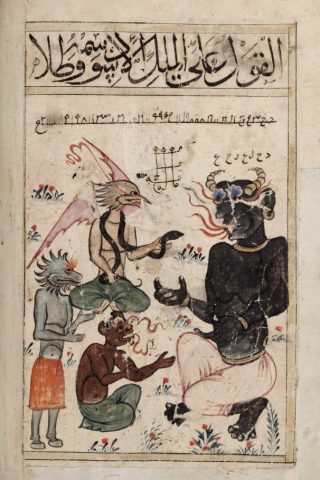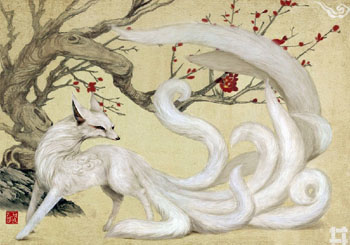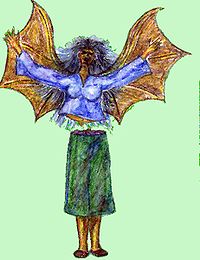Fantasy illustration is full of creatures: dragons, griffins, unicorns… everyone recognizes them. What about the lesser known ones?
Most creatures come from mythology: you surely know about Greek ones (Titans, pegasi) and probably a few Norse ones (Midgarsorm, Fenrir). Most of the fantasy creations deal with European creatures, but there’s a veritable cornucopia of different myths all around the world! Here I list some of the most curious I have found during my research.

Djinni (Islamic)
A djinni is a free-willed creature, along with humans and angels, created from fire. It’s not a single creature, but there’s a whole society of them, very similar to the human one. Little (or too much) is said about their physical appearance: they are sometimes depicted as dragons, vultures, dogs or with human shape. They possess more or less magical powers (again, depending on the depiction).
Tired of dwarfs and elves? The djinn is the creature for you!
 Aralez (Armenian)
Aralez (Armenian)
Aralezs are dog-like spirits, sometimes depicted as winged dogs, that can bring back a person to life by licking his wounds. I couldn’t find a lot of info about them, but of all the winged animals, I never came across a winged dog.
 Axehandle Hound (Northern US)
Axehandle Hound (Northern US)
Speaking about dogs, what about the Axehandle Hound? It’s a sort of dachshund-like dog, with an axe-shaped head and a long body resembling an handle. It goes around eating the handles of axes which have been left unattended. This is gonna be fun to draw.
 Kitsune (Japanese)
Kitsune (Japanese)
Kitsune is the word for “fox” in Japanese, but it is believed that all foxes can transform into humans. Kitsunes are fairy-like creatures and possess magical powers. Zenko kitsunes are the celestial and good ones, while Yako kitsunes are malevolent and mischievous. They seem to grow more tails, up to nine, when aging.
 Kelpie (Scottish)
Kelpie (Scottish)
A kelpie is a shape-shifting water spirit, appearing as an horse or in human form. When in human shape, it usually retains its hooves, thus being quite easy to identify. According to Scottish folklore, the kelpie is a black stallion that lives in body of waters, preying on humans when they get close by. In Christian times it has been associated with the traditional depiction of Satan.
 Undine (European Renaissance)
Undine (European Renaissance)
Another water creature. Undine is a sort of umbrella term for all those female water dwellers (nereids, mermaids, naiads…) who sing with beautiful voices and need humans to be complete. The first definition of Undine, or Ondine, comes from Paracelsus, who thus named the water elemental. They appear as beautiful women, but lack an immortal soul and have to marry a man to get one. In the 1939 French play by Giradoux, the man who betrays the Undine is bound to perform every bodily function by will: if he forgets to breathe, he dies.
 Catoblepas (Ethiopian)
Catoblepas (Ethiopian)
The catoblepas is a sort of buffalo with a boar head. His head is so heavy it always points downward. It’s covered in scales and its breath can turn people to stone.
 Chonchon (Chilean)
Chonchon (Chilean)
When a powerful Kalku sorcerer uses a secret magical ointment, his head detatches from the body and becomes a Chonchon. This is a legendary creature that flies in the moonless nights bringing bad luck. It consists in a feathered human head with sharp talons and big winglike ears.

Manananggal (Filipina)
The woman-like creature that goes by that unpronounceable name is a sort of vampire who preys on pregnant women, sucking the unborn fetus with a proboscis tongue. She can separate her torso from the lower body and sprout bat-like wings. Oddily enough, she seems to possess the same weaknesses as the traditional vampire (garlic, salt, daggers, daylight…).
 Leshy (Slavic)
Leshy (Slavic)
A Leshy is a forest guardian spirit. They are shapeshifter, and can thus assume any form, but they are originally masculine and similar to a giant. Sometimes they go around and lead travellers astray, but they are not evil in themselves.